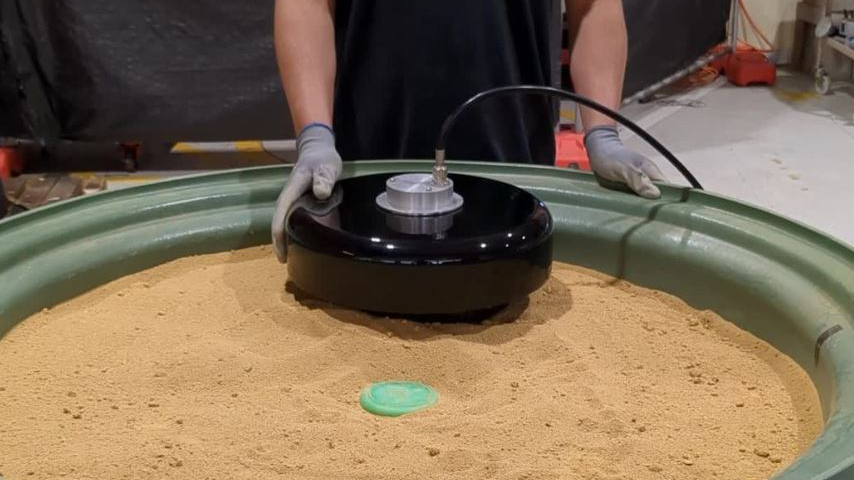Magnetic Resonance Detector Finds Mines Fast
Magnetic Resonance Detector Finds Mines Fast


Older detectors used to find land mines from wars past make it a slow process—with devastating consequences. But a new mine detector can recognize an explosive in an instant.
Land mines kill more than 5,000 civilians every year and injure more than 15,000. It’s not a problem that goes away easily. Egypt, the country with the most buried mines, has had more than 20 million underground for 50 years. Iraq, Iran, and Angola each have 10 million. And Cambodia’s K5 Plan, a 700-kilometer-long, 100-meter-wide swath of land mined in the 1980s to keep out the Khmer Rouge, holds 3,000 mines per kilometer to this day.
The fact is, the current method of removing mines is a dangerous, painstaking, slow, and tedious process. Metal detectors can’t tell the difference between a mine, a nail, a piece of shrapnel, or a pull tab from a can. When a detector says it’s found something in a mine clearing operation, there’s a one in 600-odd chance that it’s actually a mine, and it has to be dug up to find out. Ground penetrating radar can help—in the right kind of soil—but even with its assistance, the ratio only goes down to one in 30. And, what’s worse, not all mines are made of metal.
“If we could detect all the low-metal mines, and just immediately confirm that they're explosive, if we could combine that with metal detection, we could dramatically speed up the demining process,” said Nick Cutmore, executive director, and chief technical officer, for MRead, and previously a research director at the Commonwealth Scientific and Industrial Research Organisation, or CSIRO, in Australia. MRead has created a tool that does just that. It’s a metal-detector sized device that uses magnetic resonance to recognize the molecular signature of different explosives. “If we sit there long enough, we’re not wrong,” he said.
Eliminating Explosives: A Three-fingered, Mine-Defusing Robot
Cutmore’s previous team at CSIRO had a lot of experience detecting explosives and other materials at the molecular level. While at CSIRO, Cutmore first tried to use magnetic resonance to recognize minerals back in the late 1990s.
“Our initial attempt was awful. It just didn’t work,” he said. “So, it was put on the shelf for a little while.”
He and his research team revisited the idea after 9/11, in the hopes of creating something to help detect explosives as part of border security. After years of work, they came up with a handheld detector that could recognize 50 grams of explosives when being swept over a person at two meters a second. It could look into the body from a distance, and since it used low levels of radio waves, was completely safe.
“But, like all good researchers, we get distracted by opportunity,” Cutmore said. That opportunity came from the Australian mining boom that started in the first decade of the 2000s.
Valuable minerals are stuck in giant blocks of rock pulled from the ground. Typically, those blocks are crushed to get at valuable metals. That crushing uses roughly three to five percent of the world’s energy. The whole process requires a tremendous amount of water and generates a huge amount of waste, or “tailings.”
To cut down both the energy and water waste, Cutmore and his CSIRO team scaled up their explosive detecting wand to a scanner that fits over a two-meter-wide conveyor belt, creating the spinoff company NextOre in the process. The scanner has a sampling period of just tens of milliseconds, allowing it to peer into 10,000 tons of rock an hour to figure out which blocks have the right minerals. Rocks that contain nothing of value or are too impure don’t get crushed. It’s good for the environment and for profits.
Become a Member: How to Join ASME
Thanks to the success of NextOre, the same team picked up where they had left off 10 years ago with smaller scale detectors for explosives and drugs.
“We made a lot of improvements to the electronics, the software, the antenna design,” said Cutmore. “And we said, maybe we can do something very special in explosives.”
They soon had a laboratory prototype that could recognize a range of primary explosive types: RDX, PETN, ammonium nitrate, and black powder. The device’s detection ability is unaffected by environmental noise in the radiofrequency spectrum, something that killed off previous work done by other researchers.
The magnetic resonance that does the work on the mine detector doesn’t need the giant magnets of an MRI machine. “The difference between hospital MRI and the magnetic resonance that we do is we still have a field, but the field we exploit is created by the local crystalline matrix of the molecule,” said Cutmore. “The big minus is it’s really difficult. The emitted signal is very weak, typically about 1016 times smaller than the exciting signal, so it’s slightly easier to listen to the big bang on the edge of the universe. What that means is the electronics are special, the sensitivity of the detection head is special, and the controlling software has to be exquisite.”
MRead plans on field testing the first-generation product in the middle of 2024 and is simultaneously working to expand the catalogue of explosives it will be able to detect. After that, it may soon be possible to make the many mined lands that exist around the world safe for walking again.
Michael Abrams is a technology writer in Westfield, N.J.

The fact is, the current method of removing mines is a dangerous, painstaking, slow, and tedious process. Metal detectors can’t tell the difference between a mine, a nail, a piece of shrapnel, or a pull tab from a can. When a detector says it’s found something in a mine clearing operation, there’s a one in 600-odd chance that it’s actually a mine, and it has to be dug up to find out. Ground penetrating radar can help—in the right kind of soil—but even with its assistance, the ratio only goes down to one in 30. And, what’s worse, not all mines are made of metal.
“If we could detect all the low-metal mines, and just immediately confirm that they're explosive, if we could combine that with metal detection, we could dramatically speed up the demining process,” said Nick Cutmore, executive director, and chief technical officer, for MRead, and previously a research director at the Commonwealth Scientific and Industrial Research Organisation, or CSIRO, in Australia. MRead has created a tool that does just that. It’s a metal-detector sized device that uses magnetic resonance to recognize the molecular signature of different explosives. “If we sit there long enough, we’re not wrong,” he said.
Eliminating Explosives: A Three-fingered, Mine-Defusing Robot
Cutmore’s previous team at CSIRO had a lot of experience detecting explosives and other materials at the molecular level. While at CSIRO, Cutmore first tried to use magnetic resonance to recognize minerals back in the late 1990s.
“Our initial attempt was awful. It just didn’t work,” he said. “So, it was put on the shelf for a little while.”
He and his research team revisited the idea after 9/11, in the hopes of creating something to help detect explosives as part of border security. After years of work, they came up with a handheld detector that could recognize 50 grams of explosives when being swept over a person at two meters a second. It could look into the body from a distance, and since it used low levels of radio waves, was completely safe.
“But, like all good researchers, we get distracted by opportunity,” Cutmore said. That opportunity came from the Australian mining boom that started in the first decade of the 2000s.
Valuable minerals are stuck in giant blocks of rock pulled from the ground. Typically, those blocks are crushed to get at valuable metals. That crushing uses roughly three to five percent of the world’s energy. The whole process requires a tremendous amount of water and generates a huge amount of waste, or “tailings.”
To cut down both the energy and water waste, Cutmore and his CSIRO team scaled up their explosive detecting wand to a scanner that fits over a two-meter-wide conveyor belt, creating the spinoff company NextOre in the process. The scanner has a sampling period of just tens of milliseconds, allowing it to peer into 10,000 tons of rock an hour to figure out which blocks have the right minerals. Rocks that contain nothing of value or are too impure don’t get crushed. It’s good for the environment and for profits.
Become a Member: How to Join ASME
Thanks to the success of NextOre, the same team picked up where they had left off 10 years ago with smaller scale detectors for explosives and drugs.
“We made a lot of improvements to the electronics, the software, the antenna design,” said Cutmore. “And we said, maybe we can do something very special in explosives.”
They soon had a laboratory prototype that could recognize a range of primary explosive types: RDX, PETN, ammonium nitrate, and black powder. The device’s detection ability is unaffected by environmental noise in the radiofrequency spectrum, something that killed off previous work done by other researchers.
The magnetic resonance that does the work on the mine detector doesn’t need the giant magnets of an MRI machine. “The difference between hospital MRI and the magnetic resonance that we do is we still have a field, but the field we exploit is created by the local crystalline matrix of the molecule,” said Cutmore. “The big minus is it’s really difficult. The emitted signal is very weak, typically about 1016 times smaller than the exciting signal, so it’s slightly easier to listen to the big bang on the edge of the universe. What that means is the electronics are special, the sensitivity of the detection head is special, and the controlling software has to be exquisite.”
MRead plans on field testing the first-generation product in the middle of 2024 and is simultaneously working to expand the catalogue of explosives it will be able to detect. After that, it may soon be possible to make the many mined lands that exist around the world safe for walking again.
Michael Abrams is a technology writer in Westfield, N.J.

Pulse of the Profession: CAD in 2030
CAD technologies and their applications have been steadily evolving ever since, ushering in a bevy of new techniques and approaches over the decades.






